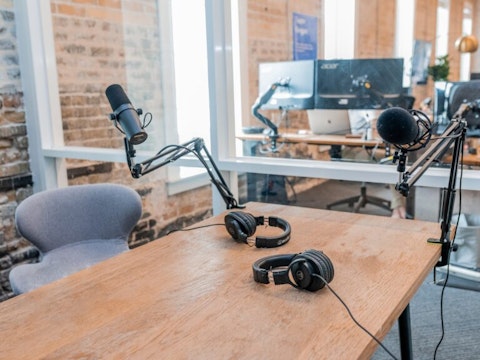Creative Media & Community Trust Corporation (NASDAQ:CMCT) Q2 2023 Earnings Call Transcript August 10, 2023
Creative Media & Community Trust Corporation misses on earnings expectations. Reported EPS is $-1.05 EPS, expectations were $0.02.
Operator: Good day, and welcome to the Creative Media & Community Trust Second Quarter 2023 Earnings Conference Call. [Operator Instructions] Please note this event is being recorded. I would now like to turn the conference over to Steve Altebrando, Portfolio Oversight. Please go ahead.
Steve Altebrando: Hello, everyone, and thank you for joining us. My name is Steve Altebrando, the Portfolio Oversight for CMCT. Also on the call today is Shaul Kuba, our Chief Investment Officer; David Thompson, our Chief Executive Officer; and Barry Berlin, our Chief Financial Officer. This call is being webcast and will be temporarily archived on the Investor Relations section of our website where you can also find our earnings release. Our earnings release includes a reconciliation of non-GAAP financial measures discussed during today’s call. During the course of this call, we will be making forward-looking statements. These forward-looking statements are based on the beliefs of, assumptions made by and information currently available to us.
Our actual results will be affected by known and unknown risks, trends, uncertainties and factors that are beyond our control or ability to predict. Although we believe that our assumptions are reasonable, they are not guarantees of future performance and some will prove to be incorrect. Therefore, our actual future results can be expected to differ from our expectations and those differences may be material. For a more detailed description of potential risks, please refer to our SEC filings, which can be found in the Investor Relations section of our website. With that, I’ll turn the call over to David Thompson.
David Thompson: Thanks, Steve, and thank you, everyone, for joining our call today. In the second quarter, we made good progress improving occupancy at our recently acquired multifamily assets. These acquisitions are part of our previously defined plan to grow the multifamily side of our portfolio to achieve more balance between creative office and multifamily assets. As a reminder, during the first quarter, we completed the acquisition of 2 multifamily assets in Oakland and 1 multifamily property in Los Angeles. These newer vintage, highly amenitized premier multifamily assets in high barrier-to-entry markets added 696 units to our portfolio. At the end of the June quarter, our overall multifamily occupancy improved to 83.9%, up 320 basis points from the prior quarter.
Two of the 3 assets we acquired in the first quarter are still in their initial lease-up phase. We believe there’s an opportunity to significantly grow net operating income at these properties as we execute on completing the lease-up. During the quarter, we also made significant progress on our development pipeline, most notably in Austin, where we can now develop multifamily by-right at both our Penn Field and East 7th Street properties. Shaul will provide more detail on this positive update. We also took further steps to improve our liquidity and balance sheet during the quarter. We paid down our credit facility by $30 million in the quarter, primarily with proceeds from our Series A1 Preferred Stock offering. Turning to the second quarter financials.
We continue to see a strong rebound in our hotel NOI, which increased by 28% from the prior year period. Our multifamily segment generated just over $0.5 million in NOI in the quarter. As I mentioned earlier, we believe there’s an opportunity to significantly grow our multifamily NOI as our assets continue to lease up. Our office NOI declined on a year-over-year basis but increased from the first quarter due to higher occupancy. Our lending NOI decreased year-over-year, partially due to the securitization completed in the first quarter, which increased interest expense attributable to that segment. I would now like to turn the call over to Shaul Kuba.
Shaul Kuba: Thank you, David. I will provide some more color on some recent positive update on our development pipeline and then give an update on some of our recent acquisition. Starting in East Austin. At our East 7th Street properties, a multifamily entitlement was approved in June, allowing us to build up to 145 multifamily units on 2 adjacent properties. We spent several years assembling this project. The development will replace the existing single-story office building. The East 7th Street corridor is among the most desirable locations in Austin, with numerous food and dining options within close proximity and providing direct access to both the central business district and east side. We also received good news at our Penn Field campus in July.

Photo by Austin Distel on Unsplash
We were successful in changing the zoning so that the entire 16-acre campus is now entitled for multifamily. This gives us the ability to add residential alongside our successful creative office building. We are now in the planning phases of those Austin area developments, and we’ll have more information in future call. As we have previously discussed in those calls, those value creation opportunities are the result of an extensive review of our portfolio last year. Turning to our Los Angeles properties. Work is continuing on our partial office to multifamily conversion at 4750 Wilshire Boulevard. We continue to expect the project to start leasing-up in the fourth quarter of 2024. This will add another 68 residential units to the portfolio.
We believe this is a very attractive project, given the asset location in Hancock Park, a supply-constrained neighborhood that is adjacent to a multimillion-dollar single-family home. We also now have 2 ground-up development projects that are fully entitled: our 40-unit multifamily project in Jefferson Park and our 36-unit multifamily development in Echo Park, which is a joint venture between CMCT and an international institutional investor. Currently, we are in the process of obtaining building permit and have the option to start construction this year. Our creative office building at 1910 W. Sunset Blvd is now 94% leased, up from 74% a year ago. Echo Park is a trendy walkable submarket with numerous dining and entertainment options. There is a limited office supply in this submarket, and our 8-storey building is the tallest in the area, providing spectacular views across Los Angeles.
For the balance of our development pipeline, we continue to work to obtain all the necessary approvals as well as completing the design work, which we believe will increase the value of those holdings and allow for future growth. As we have previously mentioned, for development assets, we will look to bring in a co-investor to increase our diversification and supplement return by generating fee income when advantageous, just like we have done at 4750 Wilshire Boulevard. Now for the update on our recent multifamily acquisition. First, in Echo Park in Los Angeles, 1902 Park Avenue, a 75-unit apartment building was acquired in the first quarter this year in an off-market transaction. Our bases in 1902 Park Avenue is highly attractive at approximately $300,000 per door.
We have made several small cosmetic changes, including upgrading the landscaping, lighting and common amenities to the building, which require limited CapEx. We believe this will have an outsized impact on the desirability of the building for residents and provide a significant opportunity to increase rent to market rate over time as new tenants move in. Next, an update on 2 Oakland properties that David discussed. As you may recall, we completed those acquisitions last quarter: the Channel House, a 333-unit apartment building, and 1150 Clay, a 288-unit apartment building. Both assets are premier Class A buildings that were completed in 2021. We are making some progress improving occupancy at both assets. Oakland is a market that saw significant supply growth from 2018 through 2022.
Our efforts are continuing to generate results, though we also expect it to take some time for the new supply to be fully absorbed. It is also important to note that the pipeline for new development in Oakland is well below the average for the top 25 U.S. markets. Therefore, local rents would need to increase dramatically before it is economic to see significant multifamily construction to start again. With that, I will turn it over to Steve to provide a further update on the portfolio.
Steve Altebrando: Thanks, Shaul. I’ll provide a quick update on our leasing activity. Starting with the multifamily portfolio, on a consolidated basis at quarter end, our multifamily was 83.9% occupied compared to 80.7% at the end of the first quarter. The increase was driven by higher occupancy in our recently acquired Oakland assets. Occupancy at Channel House increased to 81.4% at the end of the quarter, up 1.5 percentage points compared to the end of the first quarter. And occupancy at 1150 Clay also increased to 86.5% at the end of the quarter, up 6.5 percentage points from the end of the first quarter. At 1902 Park in Los Angeles, our in-place rents are well below market, and we have been executing new leases for new tenants at a substantially higher rate.
Turning to office, we leased approximately 29,000 square feet in the second quarter. Our occupancy rate at the end of the second quarter was 83%, up 170 basis points from the prior quarter, while our lease percentage was 84.5%, up 10 basis points from the prior quarter. On a year-to-date basis, our cash leasing spreads are up about 20 basis points while our GAAP leasing spreads are up about 3.3%. With that, I’ll turn it to Barry.
Barry Berlin: Thank you, Steve. Moving on to financial highlights. Our segment NOI decreased to $12 million for the second quarter of 2023 compared to $12.8 million in the prior year comparable period. This decrease in NOI was driven by a $1.2 million decrease in our lending segment NOI as well as a $1.1 million decrease in our office segment NOI. This was partly offset by a $900,000 increase in our hotel segment as well as a $500,000 contribution from our newly-acquired multifamily segment. Our lending segment NOI was impacted by the leverage achieved from the securitization in Q1. Interest relating to the securitization is directly expensed at the lending segment level, which in turn freed up capital to allow us to further our strategic business model, including the multifamily acquisitions.
Our hotel segment NOI continued its positive quarter-over-quarter trend and increased to $4.1 million from $3.2 million in the prior year. This was driven by both improved occupancy for the quarter, which increased to 81% from 78% and improved ADR for the quarter, which increased to $201 per room from $176 per room. As mentioned, we recorded a $0.5 million NOI from the new multifamily segment. We began reporting multifamily segment NOI in the first quarter of 2023 after we acquired 2 multifamily properties in Oakland in late January and late March as well as invested in another multifamily property in Los Angeles through a 50-50 joint venture investment. Finally, our lending division NOI decreased to $524,000 from $1.7 million in the prior year comparable period.
This was primarily due to the increased interest expense related to the issuance of the new SBA 7(a) loan-backed notes in connection with the securitization that closed in March 2023 as well as an increase in allocated payroll costs. For our nonsegment expenses, we had 2 significant events. The largest was an increase of $15.5 million in depreciation and amortization expense. This noncash expense increase was driven by an increase in acquired in-place lease intangible asset amortization at our new multifamily properties located in Oakland. The remaining asset balance of around $9.4 million for those assets will be absorbed during the remainder of 2023. The second item being an increase in nonsegment allocated interest expense, which increased by around $5.1 million, primarily due to market interest rate rises and the assumption of 2 mortgages, as well as borrowing on a revolver in connection with the acquisition of our 2 multifamily properties in Oakland during the first quarter of 2023.
Our FFO was negative $0.19 per diluted share compared to positive $0.11 in the prior year comparable period. And our core FFO was negative $0.17 per diluted share compared to a positive $0.11 per share in the prior year period. These reductions were primarily driven by the increase in interest expense, largely due to our multifamily acquisitions, 2 of which are still in their initial lease-up. As David mentioned, we believe there is an opportunity to significantly grow our multifamily NOI. Finally, our liquidity was bolstered by raising an additional $27.4 million in net proceeds from the sale of our Series A1 Preferred Stock during the quarter. At June 30, we had approximately $58 million of additional borrowing capacity. With that, our host can now turn the call over for questions.
See also 10 Oversold Healthcare Stocks to Buy and 25 Most Congested Cities in the US.
Q&A Session
Follow Creative Media & Community Trust Corp (NASDAQ:CMCT)
Follow Creative Media & Community Trust Corp (NASDAQ:CMCT)
Operator: [Operator Instructions] The first question today comes from Brendan McCarthy with Sidoti.
Brendan McCarthy: I’m wondering if you can provide an update on the Kaiser Permanente lease expiration — or upcoming lease expiration? Any details that you’re able to provide?
Steve Altebrando: So Kaiser’s lease, I think, runs through 2025 and then part of it through 2027. They have been pretty public about their plans to stay in Oakland. We obviously feel very good about our asset. We view it as the best — the premier building really in Oakland. So we feel good about the outlook for 1 Kaiser and the building, but not much we can report beyond that.
Brendan McCarthy: Okay, that’s understandable. And then lastly, just reading through some of the slide deck information. I know you talked about a target capital structure. I’m wondering if you can expand on the timing outlook on that target capital structure. I believe it’s — you’re aiming for 40% debt, 30% preferred and the rest, common. What’s — I guess, are you able to provide what the outlook like to eventually — or what the outlook is like to eventually achieving that target?
Steve Altebrando: Yes, so that’s a target that basically is over time. Today, we’re a little bit below that target, given the couple of acquisitions that we completed in the first quarter. But there’s really — there’s no hard and fast rule in terms of when we get back in line. I mean, we would expect when we look at our — and by the way, that capital structure is based on the fair value of our assets, of which we believe there is some upside as well. So we would — there’s no set time period but over time, that is a guideline that we’d like to stick to. We felt these were very compelling acquisitions and so we proceeded with them, knowing that we were dipping a little bit below the target. But we would expect over the next couple of years that we would get back in line with those targets.
Brendan McCarthy: Got it. That’s helpful. And 1 more. Is it still reasonable to expect roughly $30 million of A1 Preferred issuance per quarter?
Steve Altebrando: Yes. That’s about where we’ve been tracking so I think that’s a reasonable go-forward assumption.
Operator: [Operator Instructions] The next question comes from Craig Kucera with B. Riley.
Craig Kucera: I wanted to circle back to the intangible write-off this quarter. So I know when you acquired the apartment buildings, you did take a pretty substantial intangible as a component of that acquisition. And it looks like you wrote off quite a bit of it this quarter. Can you kind of walk us through what was kind of the accounting there and sort of what’s going on there?
David Thompson: Yes, this is David. I can take that. And Craig, thanks for calling. We appreciate it. We appreciate the question. Yes, so this really kind of goes — gets into kind of accounting nuance a little bit, but we’re — we use an independent firm to kind of do the purchase price allocation when we acquire an asset. And the thing you run into is a bit unusual with respect to multifamily is they put a value on the in-place leases. And it’s not the above-market or below-market. It’s just the fact that you have leases there themselves. And it’s generally based on the revenue that those leases generate, not kind of the net income. So you end up with a relatively large amount of value ascribed to this intangible asset that really has a — if you think about multifamily properties, you’ve got leases that are generally 1 year.



